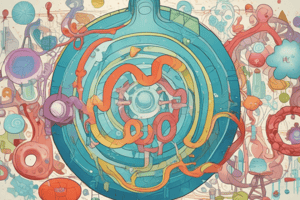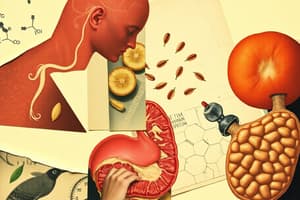Podcast
Questions and Answers
What is the primary excretory form of nitrogen for ureotelic organisms?
What is the primary excretory form of nitrogen for ureotelic organisms?
- Amino acids
- Uric acid
- Urea (correct)
- Ammonia
All amino acids are metabolized in the liver.
All amino acids are metabolized in the liver.
False (B)
Name one amino acid that plays a central role in nitrogen metabolism.
Name one amino acid that plays a central role in nitrogen metabolism.
Glutamate
The process of converting ammonia to urea in the liver is known as the ______.
The process of converting ammonia to urea in the liver is known as the ______.
Match the following amino acid groups with their excretory forms.
Match the following amino acid groups with their excretory forms.
What is the primary one-carbon group that Biotin transfers?
What is the primary one-carbon group that Biotin transfers?
S-adenosylmethionine transfers methyl groups, which are the most oxidized state of carbon.
S-adenosylmethionine transfers methyl groups, which are the most oxidized state of carbon.
What is the enzyme defect associated with Alkaptonuria?
What is the enzyme defect associated with Alkaptonuria?
The accumulation of phenylalanine and phenylpyruvate in the blood leads to a condition known as _____ .
The accumulation of phenylalanine and phenylpyruvate in the blood leads to a condition known as _____ .
Match the following diseases with their characteristics:
Match the following diseases with their characteristics:
Flashcards are hidden until you start studying
Study Notes
Proteins and Proteolysis
- Proteases hydrolyze peptide bonds, breaking down larger polypeptides into smaller peptides and amino acids.
- Endopeptidases cleave peptide bonds within the molecule, while carboxypeptidases remove amino acids from the carboxyl end.
- Pepsin hydrolyzes proteins at the amino-terminal side of Leucine, Phenylalanine, Tryptophan, and Tyrosine.
- Trypsin cleaves peptide bonds involving Lysine or Arginine, which are positively charged amino acids.
Amino Acid Metabolism
- Amino acids are metabolized primarily in the liver and contribute to common intermediates of the Krebs cycle.
- There are 20 standard amino acids, each having unique metabolic pathways.
- Protein contributes about 10% of energy production in humans.
- Proteins are not stored; protein production depends on metabolic conditions.
- Excess protein intake, metabolic disturbances, or starvation lead to accelerated degradation of proteins.
Nitrogen Metabolism and Excretion
- Ammonia is generated from amino acid metabolism; its fate differs among organisms:
- Ammoniotelic organisms excrete ammonia,
- Ureotelic organisms convert it to urea,
- Uricotelic organisms convert it to uric acid.
- Key amino acids involved in nitrogen metabolism include Glutamate, Glutamine, Alanine, and Aspartate.
- Excess ammonia from other tissues is transported to the liver for conversion into excretory forms.
One-Carbon Transfer Reactions
- Biotin transports carbon in its oxidized form (CO2).
- Tetrahydrofolate transfers one-carbon groups at varying oxidation states.
- S-adenosylmethionine transfers methyl groups, representing the most reduced form of carbon.
Amino Acid Catabolism Pathways
- Threonine degradation leads to succinyl-CoA, with a minor contribution to glycine in humans.
- Several amino acids are degraded to Acetyl-CoA: Phenylalanine, Tyrosine, Tryptophan, Lysine, Leucine, Isoleucine, and Threonine.
Phenylketonuria (PKU)
- PKU results from the accumulation of phenylalanine and phenylpyruvate, causing developmental brain impairments due to toxicity.
- Characteristic urine odor from phenylacetate detection by clinicians.
- Management includes a phenylalanine-restricted diet and supplementation with phenylalanine ammonia lyase.
Alkaptonuria
- Caused by a defect in homogentisate dioxygenase, leading to black urine upon oxidation of homogentisate.
- Generally less serious than PKU, but can lead to arthritis.
- Represents a significant historical example in studies of metabolism.
Key Amino Acids in Metabolism
- Glutamate and Glutamine have central roles in nitrogen metabolism, converting to α-ketoglutarate.
- Alanine converts to pyruvate, while Aspartate converts to Oxaloacetate.
- Transamination is widespread throughout body tissues for amino group collection.
Metabolic Pathways
- Oxidative deamination occurs in the liver, converting released ammonia into urea.
- Glutamate dehydrogenase can utilize NAD+ or NADP+ in the oxidative process.
- Glutamine also plays a crucial role in ammonia transport within the bloodstream.
Glucose-Alanine Cycle
- Alanine transports ammonia from skeletal muscles to the liver; this process uses pyruvate produced during muscle glycolysis.
- Catabolism during vigorous activity can yield pyruvate and lactate, which are shuttled to the liver.
- The cycle facilitates safe transportation of amino nitrogen without depleting essential Krebs cycle intermediates.
Studying That Suits You
Use AI to generate personalized quizzes and flashcards to suit your learning preferences.





